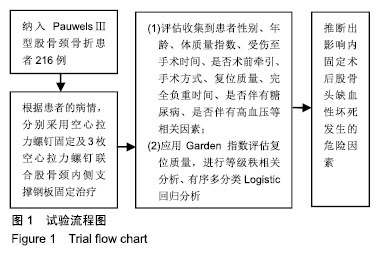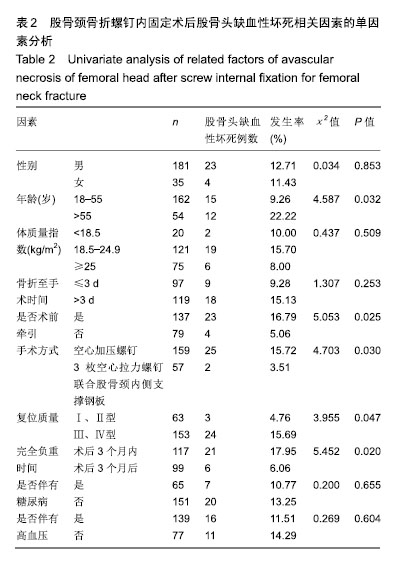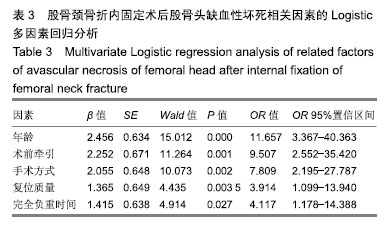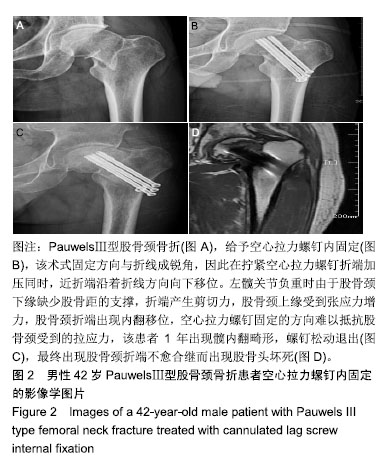| [1]Chen C,Yu L,Tang X,et al.Dynamic hip system blade versus cannulated compression screw for the treatment of femoral neck fractures: A retrospective study. Acta Orthop Traumatol Turc. 2017;51(5):381-387.[2]王青,姜达君,贾伟涛.Pauwels三型股骨颈骨折不同内固定方式的meta分析[J].上海交通大学学报(医学版),2018,38(9):1046-1052.[3]庞家省.成人股骨颈PauwelsⅢ型骨折治疗进展[J].海南医学,2018, 29(20):2936-2939.[4]刘祥,方红育,黄涛,等.股骨颈骨折空心螺钉治疗失败因素的Meta分析[J].中华关节外科杂志(电子版),2018,12(4):523-533.[5]Lazaro LE,Klinger CE,Sculco PK,et al.The terminal branches of the medial femoral circumflex artery: the arterial supply of the femoral head.Bone Joint J. 2015;97-B(9):1204-1213.[6]李少帅,张宏军.PauwelsⅢ型股骨颈骨折内固定方式的选择及常见问题探讨[J].中医正骨,2018,30(11):57-59,63.[7]吴在德,肇汉.外科学[M].6版.北京:人民卫生出版社, 2003:797-798.[8]李修洋,魏刚.股骨颈骨折空心加压螺钉内固定后股骨头坏死的相关因素[J].局解手术学杂志,2016,25(12):898-901.[9]苏晨晨,张文生,刘世平,等.中青年股骨颈骨折空心螺钉内固定术后股骨头坏死的相关因素分析[J].局解手术学杂志,2018,27(9): 665-669.[10]Wu XB,Wang JQ,Sun X,et al. Guidance for the treatment of femoral neck fracture with precise minimally invasive internal fixation based on the orthopaedic surgery robot positioning system. Orthop Surg.2019;11(3):335-340.[11]李磊,朱晨,方诗元,等.股骨颈骨折空心钉内固定术后长期疗效分析[J].中华关节外科杂志(电子版),2018,12(3):310-316.[12]胡翔,刘保健,郑永浩.不同年龄段股骨颈骨折治疗研究进展[J].中国老年学杂志,2018,38(14):3547-3550.[13]张晟,胡岩君,余斌.不同内固定方式固定Pauwels Ⅲ型股骨颈骨折模型的有限元分析[J].中国矫形外科杂志,2017,25(2):163-169. [14]王华,梅炯.股骨头颈部血供的三维全景图制作及临床意义[J].同济大学学报(医学版),2017,38(6):46-51.[15]董巍.股骨颈骨折复位内固定术后股骨头坏死的发生率调查及相关因素分析[J].中国医学创新,2018,15(12):106-109.[16]Motomura G,Yamamoto T,Yamaguchi R,et al.Morphological analysis of collapsed regions in osteonecrosis of the femoral head.J Bone Joint Surg Br. 2011;93(2):184-187.[17]柴斌,李康养,丁文彬,等.股骨颈骨折空心加压螺钉内固定术后股骨头坏死的原因分析[J].中国骨与关节损伤杂志,2017,32(2):182-184.[18]Okazaki S,Nagoya S,Tateda K,et al.Weight bearing does not contribute to the development of osteonecrosis of the femoral head. Int J Exp Pathol. 2012;93(6):458-462.[19]Schweitzer D,Melero P,Zylberberg A,et al.Factors associated withavascular necrosis of the femoral head and nonunion in patients younger than 65 years withdisplaced femoral neck fractures treated with reduction and internal fixation. Eur J Orthop Surg Traumatol.2013;23(1):61-65.[20]Scott Y,Halim BC,Werner F,et al.Does osteonecrosis of the femoral head increase surgical and medical complication rates after total hip arthroplasty? A comprehensive analysis in the United States. Hip Int. 2015;25(3):237-244.[21]庄至坤,许志庆,郭金花,等.中青年股骨颈骨折内固定术后股骨头坏死的相关因素[J].中国矫形外科杂志,2018,26(22):2044-2049.[22]Xiao J,Yang XJ,Xiao XS.DSA observation of hemodynamic response of femoral headwith femoral neck fracture during traction:a pilot study.J Orthop Trauma. 2012;26(7):407-413.[23]赵红星,黄媛霞,梁秋冬,等.股骨颈骨折复位内固定术后股骨头坏死的相关危险因素分析[J].西安交通大学学报(医学版), 2016, 37(6):906-909.[24]谢康,高维陆,常俊,等.股骨颈骨折修复后股骨头坏死7个相关因素:199例回顾分析[J].中国组织工程研究,2016,20(24): 3529-3534.[25]秦月鹏,宋莹,侯洪涛,等.两种方法治疗PauwelsⅢ型股骨颈骨折的疗效对比[J].实用骨科杂志,2018,24(10):890-893.[26]Zhang YL,Chen S,Ai ZS,et al. Osteonecrosis of the femoral head, nonunion and potential risk factors in Pauwels grade-3 femoral neck fractures A retrospective cohort study. Medicine (Baltimore).2016;95(24):3706.[27]王齐,韩国建,张宇,等.两种手术方法治疗Pauwels Ⅲ型股骨颈骨折的临床效果分析[J].中华骨与关节外科杂志,2016,9(5): 414-417.[28]Min BW,Kim SJ.Avascular necrosis of the femoral head after osteosynthesis of femoral neck fracture.Orthopedics. 2011; 34(5):349.[29]Ai ZS,Gao YS,Sun Y,et al.Logistic regression analysis of factors associated with avascular necrosis of the femoral head following femoral neck fractures in middle-aged and elderly patients. J Orthop Sci. 2013;18(2):271-276. [30]饶志涛,张英琪,陈雷,等.四枚螺钉固定Pauwels Ⅲ型股骨颈骨折的有限元研究与临床疗效分析[J].外科研究与新技术, 2018,7(2): 83-88.[31]Cha YH,Yoo JI,Hwang SY,et al. Biomechanical evaluation of internal fixation of pauwels type iii femoral neck fractures: a systematic review of various fixation methods. Clin Orthop Surg. 2019;11(1):1-14.[32]Giordano V,Alves DD,Paes RP, et al. The role of the medial plate for Pauwels type III femoral neck fracture: a comparative mechanical study using two fixations with cannulated screws. J Exp Orthop. 2019;6(1):18.[33]Tianye L,Peng Y,Jingli X,et al.Finite element analysis of different internal fixation methods for the treatment of Pauwels type III femoral neck fracture. Biomed Pharmacother. 2019; 112:108658.[34]Basso T,Klaksvik J,Syversen U,et al.Biomechanical femoral neck fracture experiments-a narrative review. Injury. 2012; 43(10):1633-1639.[35]刘福尧,刘承伟,吴声忠.不同置钉方式修复中青年移位型股骨颈骨折:复位质量及股骨头坏死率对比[J].中国组织工程研究,2015, 19(31):4983-4988.[36]Ikemura S,Yamashita A,Harada T,et al.Clinical and imaging features of a subchondral insufficiency fracture of the femoral head after internal fixation of a femoral neck fracture: a comparison with those of post-traumatic osteonecrosis of the femoral head.Br J Radiol. 2016;89(1060):1-7.[37]于乐,杨坤.外翻性股骨颈骨折患者发生股骨头缺血性坏死和内固定失败的危险因素研究[J].中华骨与关节外科杂志,2018,11(10): 746-750.[38]贺永进,李长红,刘志斌.成人股骨颈骨折术后股骨头坏死高危因素分析[J].局解手术学杂志,2016,25(8):612-615.[39]马超,王文波.空心螺钉治疗股骨颈骨折的研究进展[J].创伤外科杂志,2018,20(4):312-315. |
.jpg)




.jpg)
.jpg)